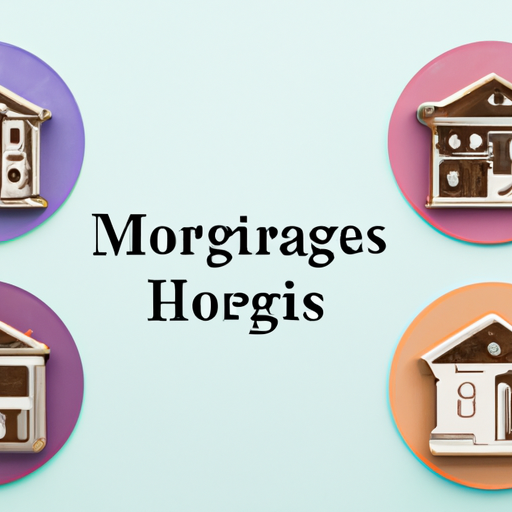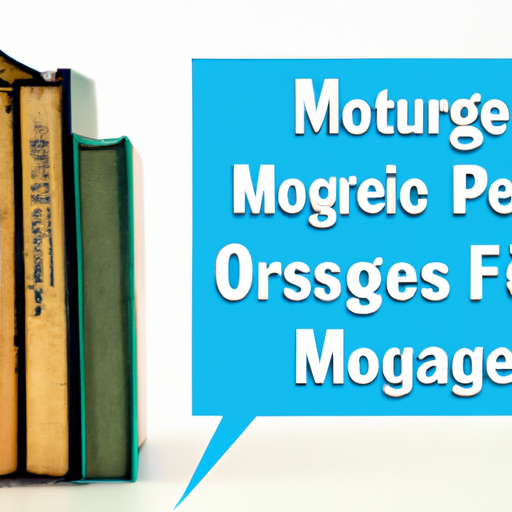In the world of mortgages, there are a multitude of options available to suit the unique needs and circumstances of every individual. From fixed-rate mortgages to adjustable-rate mortgages, it can be overwhelming to navigate through the sea of choices. But fear not, because in this article, we will guide you through the different types of mortgages and provide you with expert advice on how to choose the perfect one for you. So, if you’re ready to embark on your homeownership journey, let’s dive right in!

Fixed-Rate Mortgages
A fixed-rate mortgage is a type of mortgage in which the interest rate remains the same throughout the life of the loan. This means that your monthly mortgage payment will remain consistent, providing you with stability and predictability. Fixed-rate mortgages typically have loan terms of 15, 20, or 30 years.
Advantages
One of the main advantages of a fixed-rate mortgage is the certainty it provides. With a fixed interest rate, you won’t have to worry about your monthly payment increasing, even if interest rates in the market rise. This allows you to budget your finances more effectively and plan for the long term.
Additionally, fixed-rate mortgages offer peace of mind. Knowing that your interest rate will never change can provide a sense of stability and security. You can confidently make long-term financial decisions knowing what your mortgage payment will be for the duration of the loan.
Disadvantages
While fixed-rate mortgages offer stability, they typically come with slightly higher interest rates compared to adjustable-rate mortgages. This means that you may end up paying more in interest over the life of the loan. However, if you plan to stay in your home for a long time, the stability of a fixed-rate mortgage may outweigh the higher interest costs.
Another disadvantage is the potential missed opportunity for lower interest rates if market rates decline after you have locked in your fixed rate. Refinancing is an option to lower your interest rate, but it involves additional expenses and may not always be feasible.
How to Choose
When choosing a fixed-rate mortgage, consider the length of time you plan to stay in your home. If you intend to live in your home for the long term, a fixed-rate mortgage may be the best choice as it provides stability and predictability. However, if you anticipate moving in a few years, you may want to explore other options such as adjustable-rate mortgages.
Take into account your personal financial situation and risk tolerance. If you prefer the peace of mind that comes with a fixed interest rate and are willing to accept slightly higher rates, a fixed-rate mortgage could be the right choice for you.
Adjustable-Rate Mortgages (ARMs)
An adjustable-rate mortgage, or ARM, is a type of mortgage in which the interest rate changes periodically based on various economic factors. The initial interest rate for the ARM is typically lower than that of a fixed-rate mortgage, but it can fluctuate over time.
Advantages
The main advantage of an adjustable-rate mortgage is that it often comes with a lower initial interest rate compared to fixed-rate mortgages. This can result in lower monthly mortgage payments, especially in the earlier years of the loan.
Another advantage is the potential for savings if interest rates decrease in the future. If market rates decline, your ARM interest rate and monthly payment could also decrease, resulting in greater affordability.
Disadvantages
One of the key disadvantages of an ARM is the uncertainty associated with the changing interest rates. Your monthly mortgage payment can increase significantly if interest rates rise. This can put financial strain on homeowners who may not have budgeted for higher payments.
Additionally, predictable long-term budgeting may be challenging with an ARM because the interest rate changes periodically, making it difficult to anticipate your future housing costs.
How to Choose
When considering an adjustable-rate mortgage, it’s important to evaluate your financial situation and your ability to handle potential interest rate increases. If you expect to sell the property or refinance before the rate adjusts, an ARM may be a good option for you due to the lower initial interest rate.
However, if you plan to stay in the home for an extended period or are uncomfortable with the uncertainty of potential rate increases, a fixed-rate mortgage may be a more suitable choice.
Government-Backed Mortgages
Government-backed mortgages are loans that are insured or guaranteed by government entities. These mortgages often have more flexible requirements and lower down payment options, making homeownership more accessible to a broader range of individuals.
FHA Loans
An FHA loan is a mortgage insured by the Federal Housing Administration (FHA). These loans are popular among first-time homebuyers or those with lower credit scores. FHA loans offer competitive interest rates and require a down payment as low as 3.5% of the purchase price.
VA Loans
VA loans are mortgages guaranteed by the Department of Veterans Affairs (VA) and are available to eligible veterans, active-duty service members, and surviving spouses. These loans offer favorable terms, including no down payment requirement, competitive interest rates, and limited closing costs.
USDA Loans
USDA loans, also known as Rural Development loans, are mortgages backed by the United States Department of Agriculture (USDA). These loans are designed to assist low-to-moderate-income borrowers in eligible rural areas. USDA loans offer 100% financing, low interest rates, and low mortgage insurance premiums.
Advantages
Government-backed mortgages provide several advantages, such as more lenient credit requirements, lower down payment options, and competitive interest rates. These programs aim to make homeownership more accessible to individuals who may not qualify for conventional loans.
Disadvantages
One disadvantage of government-backed mortgages is that they often come with additional fees or insurance premiums. For example, FHA loans require mortgage insurance premiums, which add to the overall cost of the loan. VA loans may have a funding fee associated with them, although this fee can often be rolled into the loan amount.
Additionally, there may be restrictions on the type of property or location that qualifies for these loans. It’s important to research and understand the specific requirements of each government-backed mortgage program.
How to Choose
To choose the right government-backed mortgage, consider your eligibility and financial circumstances. If you meet the eligibility criteria for a particular program, such as being a veteran for VA loans or meeting income requirements for USDA loans, it’s worth exploring these options.
Evaluate the specific terms and requirements of each program, including down payment options, interest rates, and fees, to determine which loan best suits your needs and financial goals.
Interest-Only Mortgages
An interest-only mortgage is a type of mortgage in which the borrower is only required to pay the interest on the loan for a specific period, usually between five and ten years. During this initial period, the monthly mortgage payment is lower since it doesn’t include any principal repayment.
Advantages
The primary advantage of an interest-only mortgage is the lower initial monthly payment. This can provide flexibility for borrowers who may have limited cash flow in the early years of homeownership or who want to allocate funds to other investments.
Additionally, an interest-only mortgage allows borrowers to maximize tax deductions since the entire payment goes towards interest. This can be particularly beneficial for individuals with high-income tax brackets.
Disadvantages
One major disadvantage of interest-only mortgages is that they don’t build home equity during the initial period. Since no principal payments are made, the outstanding loan balance remains the same. This can limit your ability to build equity and make it more challenging to sell or refinance the property.
Once the interest-only period ends, the monthly payment will increase significantly as principal repayment is added. This can be a shock to borrowers who may not have adequately planned for the increased payment.
How to Choose
Consider an interest-only mortgage if you need lower monthly payments in the early years of homeownership. However, it’s essential to have a plan for the future when the payments increase. This may include refinancing the loan or ensuring that your income or financial situation will support the higher payments.
If building equity in your home is a priority or if you plan to sell or refinance before the interest-only period ends, an alternative mortgage option may be more suitable.

Balloon Mortgages
A balloon mortgage is a short-term mortgage that requires borrowers to make small monthly payments for a specific period, typically five to seven years. At the end of this period, the remaining balance must be paid in full, resulting in a larger payment known as the balloon payment.
Advantages
One advantage of a balloon mortgage is the lower initial monthly payments compared to traditional fixed-rate mortgages. This can be beneficial for individuals who expect an increase in income or plan to sell the property before the balloon payment becomes due.
Balloon mortgages may also be advantageous for borrowers who plan to refinance or pay off the loan early. The shorter-term can result in lower interest costs over the life of the loan.
Disadvantages
The primary disadvantage of a balloon mortgage is the risk associated with the balloon payment. If you’re unable to make the full payment at the end of the balloon period, you may be forced to refinance or sell the property. This can result in additional costs and financial uncertainty.
Additionally, balloon mortgages typically have higher interest rates compared to traditional fixed-rate mortgages, which can increase the overall cost of the loan.
How to Choose
Consider a balloon mortgage if you anticipate a significant increase in income or plan to sell or refinance the property before the balloon payment is due. Ensure that you have a clear plan in place to address the payment obligation at the end of the term.
If you prefer the stability and long-term budgeting provided by a fixed-rate mortgage, or if the uncertainty of a potentially large balloon payment is a concern, a different mortgage option may be more suitable.
Jumbo Mortgages
A jumbo mortgage is a type of mortgage that exceeds the loan limits set by government-sponsored enterprises (GSEs) such as Fannie Mae and Freddie Mac. These mortgages are typically used for higher-priced properties or in areas with higher costs of living.
Definition
The definition of a jumbo mortgage is specific to the loan limits set by the GSEs. In most areas, the loan limit for a conforming mortgage is $548,250 (as of 2021). A loan amount that surpasses this limit would be considered a jumbo mortgage.
Advantages
One advantage of a jumbo mortgage is that it allows borrowers to finance the purchase of higher-priced properties. This can be particularly beneficial in areas with expensive real estate markets.
Jumbo mortgages also offer flexibility in terms of loan programs and repayment options. Borrowers can choose from various fixed-rate or adjustable-rate options to meet their specific needs.
Disadvantages
Jumbo mortgages typically come with stricter qualification requirements compared to conforming mortgages. Lenders may require a higher credit score, a larger down payment, and a lower debt-to-income ratio. This can make it more difficult for some borrowers to qualify for jumbo loans.
Another disadvantage is that jumbo mortgages often come with higher interest rates and closing costs compared to conforming loans. This is due to the increased risk associated with larger loan amounts.
How to Choose
When considering a jumbo mortgage, evaluate your financial situation, credit score, and ability to make a larger down payment. Assess your eligibility for a jumbo loan based on the lender’s requirements and consider your ability to comfortably afford the higher monthly payments.
If you’re looking to purchase a higher-priced property and meet the qualification criteria, a jumbo mortgage can provide the financing you need. However, if the higher interest rates, stricter requirements, or larger down payment pose challenges, exploring alternative financing options may be necessary.
Reverse Mortgages
A reverse mortgage is a unique type of mortgage specifically designed for homeowners aged 62 or older. It allows homeowners to convert a portion of their home equity into loan proceeds, which can be received as a lump sum, fixed monthly payments, or a line of credit.
Definition
The definition of a reverse mortgage is a loan that allows homeowners to borrow against the equity in their homes while they continue to live in the property. Unlike traditional mortgages, reverse mortgages do not require monthly mortgage payments. The loan is repaid when the homeowner moves out of the property, sells it, or passes away.
Advantages
One of the significant advantages of a reverse mortgage is that it provides homeowners with additional income or funds to cover expenses in retirement. This can be particularly beneficial for individuals with limited retirement savings who want to age in place.
Reverse mortgages also offer flexibility when it comes to repayment. Since there are no monthly payments required, borrowers can use the loan proceeds as needed without the burden of a traditional mortgage payment.
Disadvantages
One potential disadvantage of a reverse mortgage is the impact it can have on inheritance. As the loan is repaid through the sale of the property, the remaining home equity may be significantly reduced, leaving less for heirs or beneficiaries.
Another disadvantage is the costs associated with a reverse mortgage. These loans often come with higher interest rates, origination fees, and closing costs compared to traditional mortgages. It’s crucial to carefully consider these costs and determine whether the benefits outweigh the expenses.
How to Choose
Consider a reverse mortgage if you are a homeowner aged 62 or older and need additional income or funds to cover expenses in retirement. Evaluate the costs associated with the loan and assess whether the reduced home equity will impact your estate planning or inheritance goals.
It’s also important to explore alternative options, such as downsizing or utilizing other retirement income sources, to determine the best financial strategy for your specific situation.
Interest-Only ARM
An interest-only adjustable-rate mortgage, or Interest-Only ARM, combines the features of an interest-only mortgage and an adjustable-rate mortgage. It allows borrowers to make interest-only payments for a specific period before the loan converts to a fully amortizing loan with principal and interest payments.
Definition
The definition of an Interest-Only ARM is a mortgage that starts with an interest-only payment period, usually between three and ten years. During this period, borrowers are only required to make payments towards the interest portion of the loan. After the interest-only period ends, the loan converts to a fully amortizing loan, and the monthly payment increases to include both principal and interest.
Advantages
One advantage of an Interest-Only ARM is the lower initial monthly payment during the interest-only period. This can provide flexibility for borrowers who may have limited cash flow in the early years of homeownership or want to allocate funds to other investments.
Additionally, an Interest-Only ARM offers the potential for savings if interest rates decline. Since the interest rate is adjustable, it can decrease in a low-rate environment, resulting in lower monthly payments during the fully amortizing period.
Disadvantages
One disadvantage of an Interest-Only ARM is the potential for significantly higher payments once the loan converts to a fully amortizing loan. The monthly payment can increase substantially, leading to financial strain if borrowers haven’t planned and budgeted for the higher payment.
Another disadvantage is the uncertainty associated with the adjustable interest rate. If market rates rise, the monthly payment can increase, leaving borrowers vulnerable to a potentially higher cost of homeownership.
How to Choose
Consider an Interest-Only ARM if you need lower monthly payments in the early years of homeownership but have a plan for the potential payment increase once the loan converts. Evaluate your financial situation and ability to handle fluctuating payments based on potential interest rate adjustments.
If you prefer the stability and predictability of fixed-rate mortgages or are uncomfortable with the uncertainty of potential payment increases, consider alternative mortgage options.
Bi-Weekly Mortgages
A bi-weekly mortgage is a payment plan in which borrowers make half of their monthly mortgage payment every two weeks, resulting in 26 payments per year instead of the standard 12. This accelerated payment schedule allows borrowers to pay off their mortgages earlier and save on interest over time.
Definition
The definition of a bi-weekly mortgage is a payment plan that divides the monthly mortgage payment in half and requires borrowers to make these payments every two weeks. This results in 26 half-payments per year, which is equivalent to 13 full monthly payments.
Advantages
One of the significant advantages of a bi-weekly mortgage is the potential for significant interest savings and early loan payoff. By making half-payments every two weeks, borrowers effectively make 13 full payments per year, which can accelerate the loan repayment schedule.
This accelerated payment schedule can result in substantial interest savings over the life of the loan, allowing borrowers to build home equity faster and potentially pay off the mortgage years ahead of schedule.
Disadvantages
One potential disadvantage of a bi-weekly mortgage is the lack of flexibility in payment dates. Since borrowers are required to make payments every two weeks, there isn’t the same level of flexibility as with a monthly mortgage payment.
Additionally, some lenders may charge fees or set up costs for establishing a bi-weekly payment plan. It’s essential to evaluate these costs and determine whether the potential savings outweigh the fees.
How to Choose
Consider a bi-weekly mortgage if you want to pay off your mortgage earlier and save on interest over time. Calculate the potential interest savings based on your specific loan and compare it to the fees or costs associated with setting up the payment plan.
Evaluate your budget and cash flow to ensure that you can comfortably make bi-weekly payments without straining your finances. If the potential savings and the accelerated loan payoff align with your financial goals, a bi-weekly mortgage may be a suitable choice.
Combination Mortgages
Combination mortgages, also known as piggyback loans, are a type of mortgage that involves taking out two separate loans to finance a home purchase. The primary purpose of combination mortgages is to avoid paying private mortgage insurance (PMI) and provide borrowers with more flexible financing options.
Definition
The definition of a combination mortgage is a financing arrangement that includes two separate loans: a first mortgage and a second mortgage. The first mortgage typically covers 80% of the home’s purchase price, while the second mortgage covers the remaining amount, often 10% or 15%. The second mortgage is often referred to as a piggyback loan.
Advantages
One significant advantage of a combination mortgage is the ability to avoid private mortgage insurance (PMI). PMI is typically required when a borrower makes a down payment of less than 20%. By utilizing a combination mortgage, borrowers can make a larger initial down payment, therefore avoiding the need for PMI.
Another advantage is the flexibility in financing options. Borrowers can customize the loan terms and down payment percentages based on their specific financial situation and goals. This can provide more control and potentially result in lower overall costs.
Disadvantages
One disadvantage of a combination mortgage is the potential for higher interest rates on the second mortgage or piggyback loan. Since the second loan is considered riskier for lenders, it often comes with a higher interest rate compared to the first mortgage.
Another potential disadvantage is the complexity of managing two separate loans with different terms and payment schedules. It’s crucial to understand the terms and obligations of each loan and be prepared to make multiple loan payments each month.
How to Choose
Consider a combination mortgage if you want to avoid private mortgage insurance and have the ability to customize your financing options. Evaluate the interest rates, terms, and payment schedules of both loans to ensure that you can comfortably manage the debt.
Compare the overall costs of the combination mortgage, including the potential interest rates on the second mortgage, with other loan options. If the combination mortgage offers cost savings and aligns with your financial goals, it may be a suitable choice.
By understanding the various types of mortgages available, you can make an informed decision when choosing the right one for your needs. Consider your financial situation, risk tolerance, and long-term goals to select a mortgage that provides you with stability, affordability, and flexibility. Remember to consult with a qualified mortgage professional to explore your options and receive personalized advice tailored to your specific circumstances.


